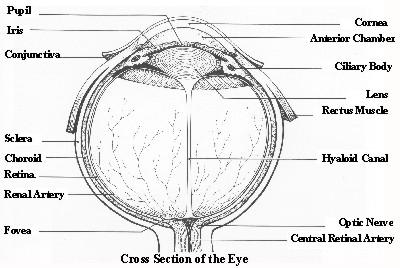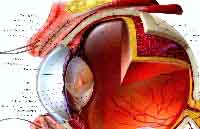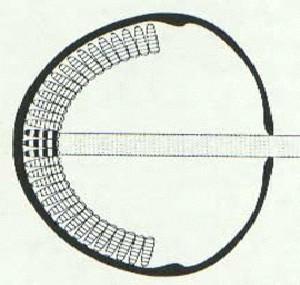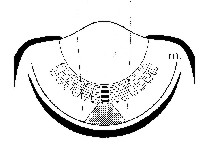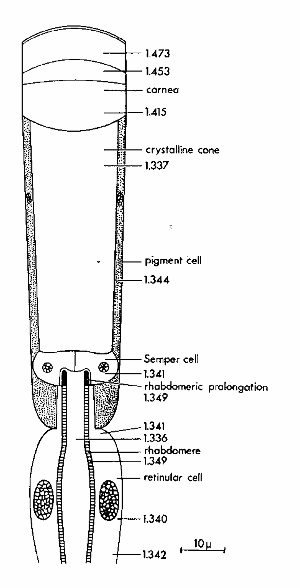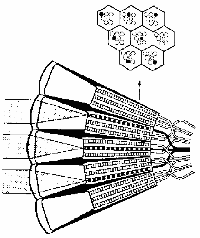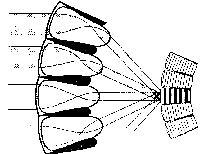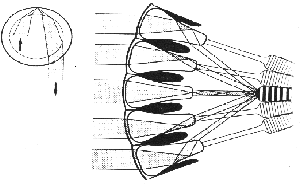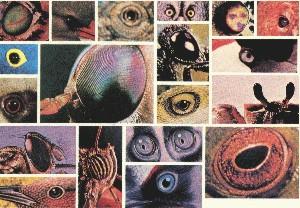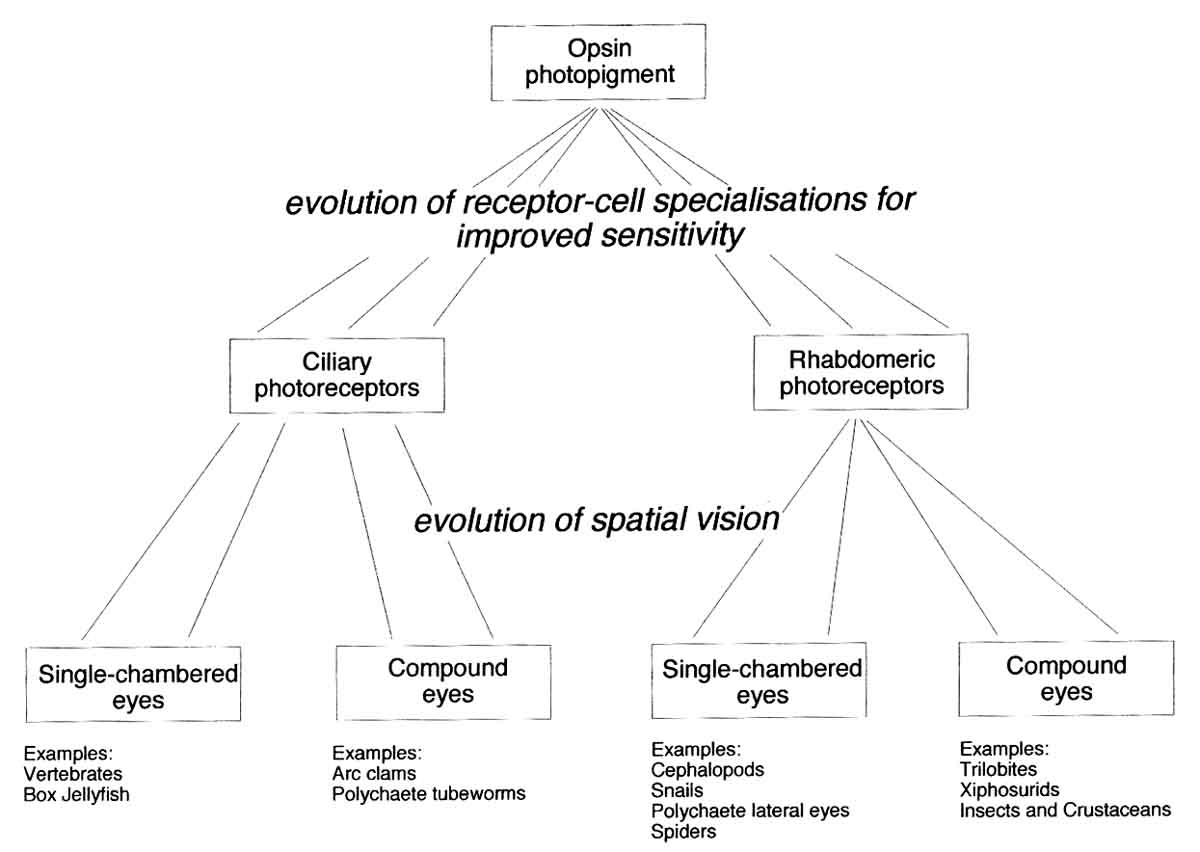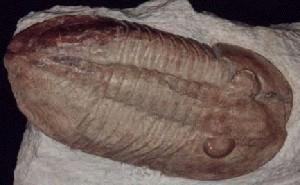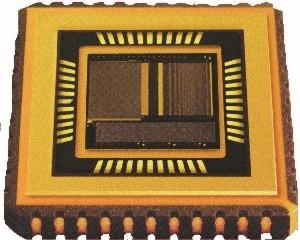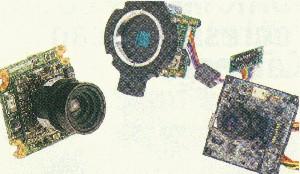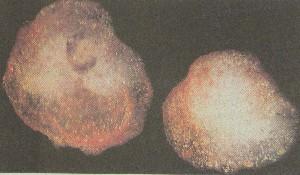(Click on underlined
link to go to subject)
Chapter 1. Vision
System Design
Chapter 2. Biological Eye Designs
Chapter
3. Eye
Design
Illustrations
Chapter
4. Eye
Reproduction
Chapter
5. Optical
Systems
Design
Chapter 6. The Eye Designer
A. Eye
design
evidence
1.
Specific
designs for
specific
needs
a.
Camera
b.
Pinhole
c.
Concave
mirror
d.
Apposition
e. Neural
superposition
f.
Refraction
superposition
g.
Reflection
superposition
h.
Parabolic
superposition
2.
Additional
design
discussion
3.
Intelligence
in
development
of building
blocks
of life
4.
Comparison
with man's
vision
system design
5. Lack of
intelligent
design
in evolutionary
theory
B. Eye
integration
design evidence
1. Eye
integration with
brain
2. Eye
integration with
other
parts of body
3.
Integrated
vision
growth
4.
Embedded
programming
of
automatic vision functions
5. Using
vision integration
technology
to control
animals
as robots
C. Design
evidence
1.
New
discoveries
relative
to vision system
design
2.
Optical
design themes
3.
Belief
in a world system designer
Related
Links
Appendix
A - Slide Show & Conference Speech by Curt Deckert
Appendix
B - Conference Speech by Curt Deckert
Appendix
C - Comments From Our Readers
Appendix
D - Panicked Evolutionists: The Stephen Meyer Controversy
Chapter 6
Section A
(Click on PICTURE IN TEXT to bring up LARGE PICTURE)
6. THE EYE DESIGNER
A. Eye
design evidence
Vision is key to many of our
body functions and activities that provide a means of establishing a
sense of community. Unfortunately, our extremely complex eyes are taken
for granted by many people. The complexity and huge variety of eyes in
insects and animals is difficult to understand without the assumption
of an eye designer. Obviously, it has taken more than natural selection
of random events to produce and optimize so many different eye designs.
In technology work, increasing
complexity often requires more intelligence, planning, and power.
The frequency of similar but
diverse eye designs
of different sizes, shapes, and materials establishes persuasive
evidence
for a single designer, as compared to random events (designs)
generating
similar creatures. Random designs are more likely to be found in the
form
of non-living rock formations of Natural Parks, such as the Carlsbad
Caverns,
Zion, or Grand Canyon, rather than in discrete, functional, living,
reproducible
vision systems.
1. Specific designs for specific needs There are specific eye designs for the unique cells of each creature. Insect eyes, relative to body size, are proportionally large, as compared to most animals. Some insect eyes are able to provide more sensitivity for better vision at low light levels by combining sensors at the cost of reducing the overall resolution. Diffraction limits of optical design impact the overall design for each of the different designs. For specific examples, we summarize and comment on the original eye design types from Chapter 2 relative to the extent of evidence for intelligent optical design.
| Evolutionists use small change arguments to justify the complexity needed for eye or vision system development. They claim that each generation would only need to contribute a positive increase in the development of eyes of 0.005 percent per generation The following Figure illustrators the evolutionary approach to eye development where Nilsson and Pelger claimed that Eyes may evolve in 400,000 generations. (Reference: Figure 1.6, p. 9, Animal Eyes, Michael F. Land, Dan-Eric Nilsson, Oxford Animal Biology series, Oxford University Press, 2002- Please see their book for more details ) |
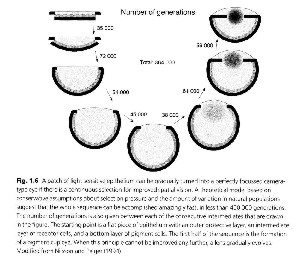
click on David Berlinski) |
d.
Apposition
Note the following detail
design of a facet for this small eye. All this happens in a diameter on
the order of a human hair. Yet the apposition compound eye design
occurs in many insects such as ants, wasps, dragonflies, honeybees, and
cockroaches. It is one of the more common small eye designs. Each of
many small facets, or lenses making up the eye, is a separate light
sensor.
These eyes occur in moths, some flies, many beetles, and some shrimp. This may be a more difficult eye to reproduce, but it does give considerable design flexibility for many small insects. An array of clear refractive or transmitting lenses works to produce an image on a small retina. Since each facet is the equivalent of a small telescope, it contains the equivalent of two lenses, to make the image upright. This optical design is similar to some gradient index lens arrays.
g.
Reflection superposition
In a reflection superposition
eye optical design, a number of reflective, instead of purely
refractive lens elements, work together to form an image on a series of
image receptors acting like a small retina. Here, principal optical
elements are reflectors rather
2. Additional Design discussion
Current image processing for
robotic application still is difficult without consistent lighting, but
living creature image processing has been in use for a long time. If
one were to assume that eyes evolve from a simple design to a more
complex design, we should have many intermediate forms that would have
poor or no vision. Evidence of "dead end" evolution, would be minimal
because creatures without good eyes would not survive. The evolution
theory has to take into account the abrupt end of the Ice Age (about
12,500 years ago). At that time there was a 20 degrees Fahrenheit
temperature increase.
3. Intelligence in development of building
blocks of life
Intelligence, beyond present
world class knowledge, is evident in virus, bacterium, and cell design
and construction (see Darwin’s Black Box by Behe). There are
increasing numbers of scientists agreeing that Darwin did not have an
answer for the source of original eye design. He certainly didn't know
about cell and vision system complexity. Here one does not have to look
far to find many current scientists who accept the necessity of
intelligent design.
All vision operating systems
in nature must be integrated with a brain for vision to occur. This
means that cells cannot function unless they are a complete system.
Comprehensive DNA programming design is evident in brain cells that
process information from the eyes in order to visualize and recognize
shapes in three dimensions. Image processing is done in both two
dimensions and three dimensions where multiple clues, such as shape,
color, texture, and dynamics of movement, all play roles in the
recognition process.
The human vision system is
probably the most versatile general-purpose image recognition system
ever built. Other designs can surpass human eye design in limited ways,
but different creatures require different functions. From what we now
know about optical systems, it appears that the intelligent design of
the eye of each creature has been optimized for its required field of
view. Since the focus point cannot be that far off at any point in the
field of view and still give a useful image, the design has to be
forgiving to accommodate minor cell differences and to provide
adaptation for environmental changes.
It is very unlikely that
intelligent programming evolved within the small brain of an insect or
any other creature. Just providing the building blocks for the storage
of visual data covering one lifetime within a small volume is a task
beyond human comprehension. Based on size and life span, it is expected
that small animals and insects do not have as much memory and brain
processing power as larger animals. This may be because their life is
very short compared to larger animals. Early creatures such as marine
invertebrates do not appear to have the intelligence to genetically
create or improve their own vision systems communication, computation
and recognition capabilities. Here we look at early Trilobite eyes.
(Adapted from www.aloha.net/~sngon /order soft Trilobite eye/Ltlin)
Click the following link for a good example of why scientists use the word design when discussing the profound complexity of eyes, even in an organism like the trilobite, extinct for more than 200,000 years. The advantage of good eye design in "The Trilobite Eye" by S. M. Gon III
4. Comparison with mankinds vision system
design
We may match many of the optical capabilities of some of Nature's eyes,
using today's technology, and yet we can't approach the small size of
complete vision systems. As we compare optics in nature with the
development of man's present optical system design capabilities, we are
amazed at what exists around us. For example, special-purpose eyes for
a select animal such as the pit viper’s visual infrared
systems are under present study by the U.S. Air Force and others to
help learn how to design better IR sensors. Similar man-made IR systems
require complex detector cooling and image processing to match the
vipers’ routine optical performance as it locates its next
meal.
Even when we compare computer
chips and cameras, which have been reduced in size, to a simple sea
slug, it still outperforms a typical portable computer vision system
with respect to overall size and efficiency of vision processing. This
comes partially from different methodologies of processing. Computer
scientists are now considering some of these methodologies for making
improvements in future vision systems. Although scientists claim
biological systems came from natural selection, they have difficulty
duplicating them with the help of modern science. On the other hand,
modern science is helping us understand vision systems of
simple-creatures”. These eyes contain technology beyond
today’s typical machine vision systems. There is more use of
thresholds, relative motion sensing, and adaptation in biological
systems than in typical machine vision systems.
Only recently have man-made
camera sensors been able to remotely compare to natural eye sensor
versatility. For example, the new smart CCD chips, where some
electronic processing is integrated in the small CCD chip used as the
image sensor in a TV camera.
Formation of each very small facet of compound eyes requires parallel chemical and electronic processing. This must be integrated within each of a wide variety of cells or building blocks to provide specific combinations of materials for optical, sensing, and computing systems. Even the simple white fly with its complex optical systems has a far smaller fully integrated vision system and control computer than man has been able to create. This is because of the small efficient complex communication linkage with the brain and other parts of the body. Some of mans' smaller computer chips are considered as smart dust, but consider the system design and manufacturing intelligence going into these small microchips.
The attention to detail is evident in the micro pattern on the moth’s eye for the reduction of reflection to aid in its survival. Man is just now able to approach such design and intricate manufacturing to achieve similar anti-reflective coatings on simple IR lenses. It has taken man over 6000 years to gain the knowledge to even ask important questions about eye design and intelligence origins.
5. Lack of intelligent design in
evolutionary theory
Despite the extreme claims of evolutionary origin theory, there is a
lack of solid evidence on intermediate formations of eyes. If animal or
insect eye types changed, as evolutionary theory specifies, it is
highly probable that insects or animals with transitional eye forms
would have died because of the lack of ability to see well enough to
survive. Also, if these intermediate forms all died, none would have
survived to change to new forms. For example, if evolutionary theory is
true, then we should find millions of different limited transitional
eye designs in fossils and in current creatures. Without this evidence,
the probability of major evolutionary changes between major eye designs
approaches zero.
It is more probable that
slight differences in eyes will regress to previous states, because of
adaptable design freedom and variations in the original gene pool of
the original eye design. Realistically, individual cells may have
variations or blemishes that could accumulate to produce differences in
eyes that may not be positive improvements. This limited flexibility
and/or adaptability of eye designs to specific environments within
types of animals also includes cell variations and
adaptability.
What is the evidence for creative mutations?
The size and functions of
insects, compared to larger animals, require different optics and image
processing to make each effective. There is little chance of a series
of helpful optical design changes in eyes occurring from random
non-intelligent inputs. For example, some eye types, such as those with
a camera type optical design, are not scalable as far as one might
think, because of optical diffraction limitations. Good optical
performance just doesn't just happen, there has to be considerable
optimization. Physical limitations on eyes can severely limit some
evolutionary theories on eyes.
Apart from that, how does one design evolve over another for a new
creature?
In some cases one could
suggest the use of more than one different eye design for one type of
creature. Adaptability and certain recombinations of genes could
actually be design features.
Questions for Discussion
Could a computer complete with a digital camera "evolve" from sand and slime?
Since all cells contain their own manufacturing systems, along with each cells individual programming, how could eye construction start without intelligent design?
If we cannot develop improved eyes with the intelligence of 100,000 scientists, how did the wide variety of eye building blocks and eye configurations evolve without an intelligent designer?
Does vision seem to be an integral part of most creatures?
Could vision have been a basic design requirement for each creature?
